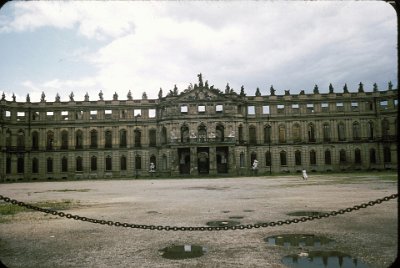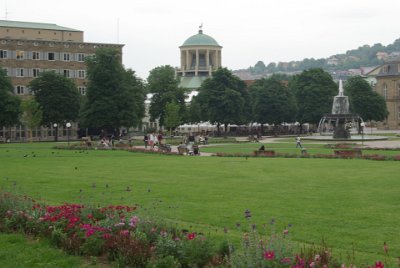 1 Thursday 17 June, 2010 After concluding our visit to the Porsche museum, we drove into Stuttgart and checked into the Hansa hotel, an easy walk to the city centre. There was no car parking available at the hotel and the desk clerk said to park the car on the street. I did not like this at all so we secured the car in an overnight parking station for only €12 which was worth it for the peace of mind it gave us. |
 2 Thursday 17 June, 2010 During WW II, the centre of Stuttgart was heavily bombed and nearly completely destroyed. In total, Stuttgart was subjected to 53 bombing raids that resulted in the destruction of 68% of all buildings and the death of 4477 people. |
 3 Thursday 17 June, 2010 Our first impressions of Stuttgart were not good. Most of it looked like a tired 1950’s city that hadn’t been modernised. It was dirty, grimy and in parts there was graffiti everywhere. Fortunately, it was only this end of the city where were were staying that was like this. |
 4 Friday 18, June, 2010 The next morning, after a very nice breakfast at the hotel, we walked into Stuttgart downtown. We were very impressed with this public toilet. This being Germany it was in working condition, spotlessly clean, conveniently located and it catered for all three sexes. |
 5 Friday 18, June, 2010 Koenigstrasse, Stuttgart's pedestrian mall, at 1km long is Germany's longest. Like many cities in Germany, what we see now is reconstructed from the ruins of WWII. I really like that when they had the opportunity to reconstruct, they eschewed skyscrapers and got rid of cars from the city centres. |
 6 Friday 18, June, 2010 This is the Königsbau in Schlossplatz commissioned in 1856-1860 by King Wilhelm I. During WWII, the Königsbau was badly damaged and was rebuilt in 1958/59. From 1991 to 2002 it housed the Stuttgart Stock Exchange and it is now part of a huge shopping centre. |
 7 Friday 18, June, 2010 Germany played Serbia and lost 0:1 |
 8 Friday 18, June, 2010 The Neuschloss (new palace) on Schlossplatz was built between 1746 and 1807. In front of the schloss are the statues of a Stag and a Lion. The water feature is the southern Schlossplatz fountain. |
 9 Friday 18, June, 2010 This is what the Neues Schloss looked like after WWII. It's just a shell. |
 10 Friday 18, June, 2010 From 1746-97 and from 1805-07 the Neuschlosse was a residence of the kings of Württemberg. The palace was almost completely destroyed during WWII, reconstructed between 1958-64 and then used by the Baden-Württemberg State Parliament. Today it is used by the State Ministries of Finance and Education. |
 11 Friday 18, June, 2010 The Jubiläumssäul (anniversary column) celebrates the 25-year jubilee and 60th birthday of King William I of Württemberg. The column is 30 meters high crowned with a bronze statue of the goddess Concordia. |
 12 Friday 18, June, 2010 The brazen (brass) statues are of of the four estates of the realm that were broad social orders recognized in the Middle Ages and Early Modern period in Christian Europe: the clergy, the nobility, and commoners with the King at the top of the three. Below the pedestal are four reliefs, three of which glorify the king's military successes against Napoleon Bonaparte. |
 13 Friday 18, June, 2010 From the Neuschloss, we walk through the Lower Schlossgarten to the Middle Schlossgarten. In 1908, construction for the new Hauptbahnhoff reduced the garden by 8 acres. |
 14 Friday 18, June, 2010 This is the Wasserspiele (water play) fountain in the Middle Schlossgarten. |
 15 Friday 18, June, 2010 The Carl Zeiss Stuttgart Planetarium offers three types of planetarium shows in English: • Live lecture about basic astronomical concepts on the current night sky • Taped planetarium show with additional live explanation of stars and constellations • Full dome video presentation using digital motion pictures Admission is €6 |
 16 Friday 18, June, 2010 This modern sculpture is outside the Staatstheater Schauspielhaus (Play House) in the Middle Schlossgarten. |
 17 Friday 18, June, 2010 Looking at the Neues Schloss from the Eckensee, a large lake in the Upper Schlossgarten. |
 18 Friday 18, June, 2010 This is the Stuttgart Staatstheater Opernhaus and it is the only major German opera house to survive the bombing of WWII. Extensive renovations between 1982 and 1984 restored it to its original condition and it now seats 1,399. |
 19 Friday 18, June, 2010 Staatstheater Stuttgart Schauspielhaus and the Opernhaus |
 20 Friday 18, June, 2010 Yours truly having a wonderful time. I love being in Germany. |
 21 Friday 18, June, 2010 In addition to the Neues Schloss, there was also an Old Castle nearby and a more modest palace, the Wilhelm Palais built in 1840. Kings treated themselves well back then. |
 22 Friday 18, June, 2010 As Germany underwent violent revolution near the end of World War I, the Kingdom of Württemberg transformed from a monarchy to a democratic republic without bloodshed. |
 23 Friday 18, June, 2010 King Wilhelm II abdicated on 30 November 1918. Following the introduction of its new constitution and the Weimar Constitution in 1919, Württemberg was re-established as a member state of the German Reich. |
 24 Friday 18, June, 2010 The Free People's State of Württemberg became the official name of the state of Württemberg during the Weimar Republic. |
 25 Friday 18, June, 2010 With the Nazi seizure of federal power in 1933, Württemberg and all other German states were abolished. |
 26 Friday 18, June, 2010 After WW II, Württemberg was split between the US and French Occupation Zones and became parts of two new states: Württemberg-Baden (US) and Württemberg-Hohenzollern (France). These two states merged with Baden in 1952 to form the modern German state of Baden-Württemberg with Stuttgart as its capital. |
 27 Friday 18, June, 2010 This is the Kunstgebäude or Art Building which was built in 1912-13. On 18 March 1920 the National Assembly of the Kapp Putsch fled to Stuttgart from Berlin and met in the Kunstgebäude. The putsch was a failed 1920 coup attempt aimed at overthrowing the Weimar Republic because of opposition to the Treaty of Versailles. The Kapp Government lasted four days. Note: the final payment for WWI reparations was finally paid on 4 October 2010. |
 28 Friday 18, June, 2010 The Kunstgebäude was destroyed in WWII, rebuilt from 1956-61 and then crowned with the golden deer. The Württemberg Art Association (with over 4,000 members) is now based in the Kunstgebäude. The great domed hall is also used for large events and exhibitions. |
 29 Friday 18, June, 2010 We walk towards the Old Castle (Altes Schloss on the left) and Schillerplatz. The Altes Schloss was built in the 10th century and was the residence of the dukes of Württemberg from the 14th century on. It was extended to a full Renaissance castle between 1553 and 1578 and rebuilt after WWII. |
 30 Friday 18, June, 2010 The Württemberg State Museum is located in the Altes Schloss. It was founded as a museum in 1869 by King William I. |
 31 Friday 18, June, 2010 We enter Schillerplatz . At the centre of the cobblestone square is a memorial to Friedrich Schiller who was a famous German poet. In 1785 he wrote An die Freude (Ode to Joy) which became the basis for the fourth movement of Beethoven's Ninth Symphony. |
 32 Friday 18, June, 2010 The Mercury atop the Merkursäule is an 1862 copy of the flying Hermes statue of Giambologna. The supporting column (säule ) was originally a water tower and the Alte Kanzlei (old chancellery) is behind the tower. These structures form the eastern end of the Schillerplatz. |
 33 Friday 18, June, 2010 This is the inner courtyard of the Altes Schloss Stuttgart. Next stop: Bad Tolz, our home for the next 12 days. |